The nuclear baton of the US Navy (part 7)
As is known, at the beginning of the 70-ies, the naval component of the US strategic nuclear forces was almost equal in number of warheads on intercontinental ballistic missiles and long-range bombers by the number of deployed strategic carriers. The great advantage of submarine rocket carriers that are on combat patrols is their invulnerability to a sudden disarming nuclear missile strike. However, when comparing the American MinibR of the Minuteman family with the 9300-13000 km range and the Polaris A-3 and Poseidon SLBMs with the 4600-5600 km range, it’s clear that rocket boats must successfully approach the enemy coast . In this regard, the command of the US Navy has pushed through the development of the ULMS strategic armament system (Undersea Long-range Missile System - long-range submarine missile system). The basis of the system was to be a SSBN with new long-range missiles that could be launched immediately after leaving the base.
At the first stage, in order to minimize the costs associated with the retooling of existing strategic missile carriers, it was decided to create a new SLBM in UGM-73 Poseidon C-3 dimensions within the EXPO program (Eng. Expanded “Poseidon” - Advanced Poseidon). Quite predictably, a tender for the development of a promising rocket in 1974 was won by Lockheed Corporation, the creator and manufacturer of Polaris and Poseidon.
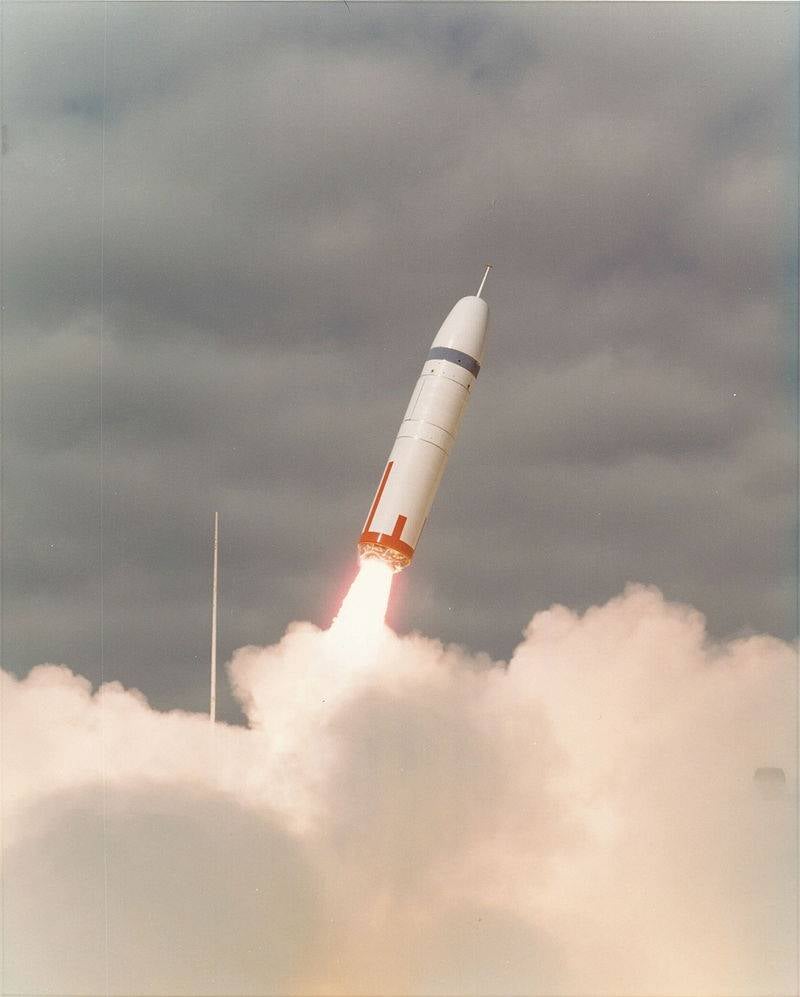
Flight tests of the missile, designated UGM-96A Trident I (also used Trident I C-4), began on Cape Canaveral in January 1977 year. And the first launch from the USS Francis Scott Key (SSBN-657) of the Benjamin Franklin type took place in July of the 1979 year. In October of the same year, this SSBN was the first atomic submarine that went on combat patrol with UGM-96A Trident I.
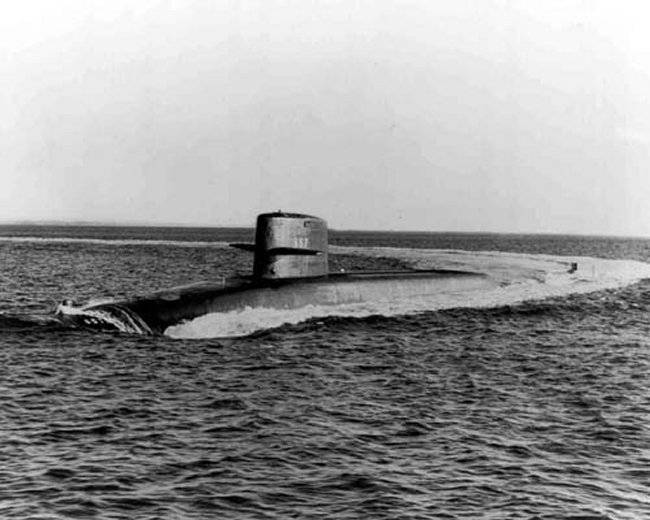
To increase the launch range, the Trident-1 rocket was made in three stages. In this case, the third stage is located in the central opening of the instrument compartment. For the manufacture of solid fuel engines used a well-developed technology of winding fibers with sizing it with epoxy resin. At the same time, unlike the Polaris A-3 and Poseidon missiles, where fiberglass and carbon fiber were used, the Keidlar thread was used on the Trident to reduce engine mass. The substance “nitrolan” mixed with polyurethane was used as a solid fuel. Pitch and yaw control on each engine was carried out by a swinging nozzle made of graphite-based material. Achievements in the field of microelectronics have reduced the mass of the electronic equipment in the guidance and control system, compared with the same unit of the Poseidon rocket by more than half. The use of lighter and more durable materials for the manufacture of engine housings, nozzles and thrust vector control elements, as well as the use of rocket fuel with a large specific impulse and the introduction of the third stage made it possible to increase the firing range of the Trident-1 rocket compared to Poseidon by approximately 2300 km - that is, at a distance equal to the firing range of the first American SLBM "Polaris A-1".
The three-stage UGM-96А Trident I 10,36 m and 1,8 m SLMs had a starting mass depending on the equipment variant: 32,3 - 33,145 t. As a combat load, it was originally intended to use eight warheads Mk.4 with individual guidance equipped with fusion warheads WNNX 76 ct each.
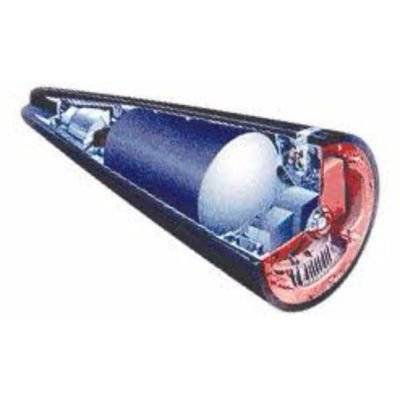
The thermo-nuclear warhead W76 was developed by the Los Alamos National Laboratory and was in production from 1978 to 1987 year. At the Rokkiflet nuclear plant in Golden, Colorado, the company Rockwell International assembled 3400 warheads.
For targeting warheads on the target used the so-called "principle of the bus." Its essence is as follows: the head part of the rocket, after conducting astrocorrection of its location, targets the first target and fires the warhead, which flies to the target along a ballistic trajectory, then the location of the warhead breeding system is re-corrected, and the second is targeted Aim and shoot the next combat unit. A similar procedure is repeated for each warhead. If all warheads are aimed at one target, then a program is laid into the guidance system that allows you to strike with a separation in time. The maximum firing range is 7400 km. Through the use of astrocorrection, for which an optical telescope and a star sensor on a vidicon were on board the rocket, the CER was within 350 m. When the astrocorrection equipment failed, guidance was provided using an inertial system, in this case the CEP increased to 800 m.
The launch procedure for the UGM-96A Trident I was no different from the SLBMs already in service. Approximately in 15 minutes after receiving the corresponding order, the first rocket could start from the board of the submarine. After the pressure in the launch shaft aligns with the outboard and the solid shaft cover opens, the rocket in the launch pad is isolated from water only by a thin destructible dome-shaped asbestos-fiber-reinforced phenolic resin membrane. In the process of launching a rocket, the membrane is destroyed with the help of profiled explosive charges installed on its inner side, which allows the rocket to freely leave the mine. The release of the rocket occurs gas-vapor mixture produced by the powder pressure generator. The formed powder gases pass through the water chamber, cooled and diluted with condensed steam. After getting out of the water, the launch of the first-stage engine occurs at an altitude of 10-20 m. Elements of the launching cup are thrown overboard with the rocket.
As already mentioned in the previous parts of the review, the first American SSBNs of the “George Washington” type, created on the basis of the Skipjack torpedo submarines, experienced serious difficulties in maintaining the target depth during rocket launches. This deficiency was largely eliminated by boats of the Eten Allen type, but finally managed to get rid of the unstable horizontal position during rocket launches on the Lafayette-class SSBNs, modernized such as the Benjamin Franklin and James Madison. After the creation of special automata, which control the operation of gyroscopic stabilizing devices and the transfer of water ballast, the task of stable maintenance of a given depth was solved to keep the boat from failure to the depth or abrupt ascent.
As already mentioned, the new rocket was created mainly to enhance the strike capabilities of nuclear-powered rocket boats already in service. It must be said that the fundamental difference in the design of American SSBNs from the approach adopted in the USSR was standardization in the creation of the "SLBM - launching mine" complex. In the Soviet design offices for each new rocket designed its own boat. Initially, three sizes of rocket shaft diameters for SLBMs were installed in the USA:
"A" - with a diameter of 1,37 m.
"C" - with a diameter of 1,88 m.
"D" - with a diameter of 2,11 m.
At the same time, the mines on the SSBNs were originally designed and manufactured slightly higher in height than the SLBMs that are in service, so to speak, “for growth”. Initially, extended-range missiles were planned to re-equip the 31 SSBNs with the Poseidon 16 SLBM each. Also, 8 new generation Ohio-type boats with 24 missiles were to be commissioned. However, due to financial constraints, these plans have undergone significant adjustments. During overhauls of the UGM-96A Trident I submarine-launched submarine missiles, six “James Madison” and six “Benjamin Franklin” submarines were re-equipped.
The Trident-1 missiles, as it was planned, armed the first eight boats of the new generation of the Ohio type. At the time of creation, all the achievements of American submarine shipbuilding were concentrated in these strategic missile carriers. Based on the operating experience of the first and second generation SSBNs, Electric Boat engineers not only increased their secrecy and strike power, but also tried to provide maximum comfort for the crew. Special attention was also paid to increasing the service life of the reactor. According to data published by the developer of the S8G reactor, General Electric Corporation, its life without replacing the core is approximately 100 thousand hours of active work, which is equivalent to about 10 years of use of the reactor. On Lafayette type boats, this figure is about 2 times smaller. Increasing the reactor operation time without replacing nuclear fuel made it possible to extend the interval between repairs, which in turn had a positive effect on the number of boats in service, and reduced operating costs.
The introduction of the head boat USS Ohio (SSВN-726) in combat fleet Held in November 1981 On boats of this type there is a record number of missile silos - 24. However, the underwater displacement of the Ohio SSBNs inspires respect - 18 tons. The length of the submarine is 750 m, the hull width is 170,7 m. Thus, with a significant increase geometrical dimensions, the underwater displacement of the SSBN "Ohio" in comparison with SSBN type "Lafayette" increased by almost 12,8 times. The use of special steel grades: HY-2,3/80 - with a yield strength of 100–60 kgf / mm made it possible to bring the maximum immersion depth to 84 m. Working depth - to 500 m. Maximum underwater speed - up to 360 knots.
Thanks to the use of a number of original design solutions, boats of the Ohio type, compared to Lafayette type SSBNs, have reduced noise from 134 to 102 dB. Among the technical innovations that made it possible to achieve this were: single shaft propulsion, flexible couplings, various connecting devices and shock absorbers for insulating the propeller shaft and pipelines, a lot of noise absorbing inserts and sound insulation inside the case, using a low noise minimum stroke with the exception of circulation pumps and low speed low noise screws of a special form.
With the impressive performance of the boat, the cost was also impressive. Without the missile complex, the headboat cost the US military budget $ 1,5 billion. However, the admirals were able to convince lawmakers of the need to build two batches of the total number of 18 submarines. The construction of the boats continued from 1976 to 1997 year.
For the sake of justice, I must say that underwater atomic bomber of the Ohio type are really very good. Due to the high technical excellence, a large margin of safety and a significant modernization potential, all built boats are still in service. Initially, all the Ohio-type SSBNs were deployed at the Bangor (Washington) naval base on the Pacific Coast. They became part of the 17 Squadron and replaced decommissioned missile boats of the type “George Washington” and “Eten Allen” with the “Polaris A-3” missiles. The James Madison and Benjamin Franklin SSBNs were based mainly on the Atlantic base of Kings Bay (Georgia), and operated until the middle of the 90's. It must be said that the use of boats armed with Trident-1 missiles was high. On average, each boat went on three combat patrols per year, lasting up to 60 days. The latest UGM-96A Trident I missiles were decommissioned in the 2007 year. The dismantled W76 warheads are used to equip Trident II D-5 missiles or transferred to storage.
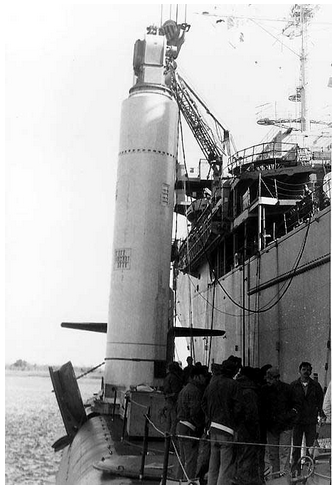
For medium repair, replenishment and ammunition could be used naval base on the island of Guam. Here, in addition to the repair infrastructure, there were permanent supply ships, in whose holds were also stored ballistic missiles with nuclear warheads. The implication was that in the event of an exacerbation of the international situation and an increase in the threat of a global conflict, the supply ships accompanied by the escort would leave the base in Guam. After the ammunition was used up, American SSBNs were to meet at sea or in ports of friendly states with floating arsenals and replenish supplies. In this case, the boats at sea, retained their combat effectiveness, even with the destruction of the main American naval bases.
The purchase of the last installment of the Trident - 1 took place in 1984. In total, Lockheed Corporation supplied 570 missiles. The maximum number of deployed UGM-96A Trident I SLBMs on 20 boats was 384 units. Initially, each missile could carry eight 100-kiloton warheads. However, in accordance with the provisions of the START-1 agreement, the number of warheads on each rocket was limited to six units. Thus, on American SSBNs, Trident-1 SLBM carriers could be deployed over 2300 units with individual guidance. However, on the boats that are on combat patrol and capable of launching their missiles in 15 minutes after receiving the corresponding order, there were not many more 1000 warheads.
The creation and deployment of the UGM-96A Trident I well demonstrates the US Navy’s strategy for building the naval component of the strategic nuclear forces. As a result of an integrated approach and cardinal modernization of existing boats and the construction of new ones, and by increasing the firing range, it was possible to drastically reduce the effectiveness of the Soviet anti-submarine forces. Reducing the QUO warheads made it possible to achieve a fairly high probability of hitting fortified point targets. According to information published in the American media, military experts in the field of nuclear planning with the "cross" pointing of several warheads of various Trident - 1 missiles at one target such as silo-propelled missile systems, evaluated the possibility of achieving its destruction with probability 0,9. And such an alignment, with the preliminary decommissioning of the Soviet Early Missile Warning System (EWS) and the deployment of space and ground-based components of the anti-missile defense, already made it possible to hope for victory in a nuclear war and minimize damage from a retaliatory strike. In addition, intercontinental-range submarine-launched ballistic missiles had important advantages over the ICBM deployed in US territory. The launch of the Trident - 1 SLBM could be carried out from sections of the World Ocean and along trajectories that made it difficult for Soviet radars to detect early warning systems. When conducting patrols in areas that were traditional for American SSBNs with the Polaris and Poseidon missiles, the flight time of the Trident-1 SLBMs to targets located deep inside Soviet territory was 10-15 minutes, against 30 minutes for MBR "Minuteman."
However, even for the most ardent American “hawks” by the middle of the 80's, it was obvious that with the presence of more than 10 000 deployed nuclear charges in the USSR on strategic carriers, the hopes for victory in global conflict are not realistic. Even with the most successful US development and liquidation, 90% of Soviet silos, ICBMs, SSBNs, long-range bombers, all strategic forces control centers and top military-political leadership of the surviving Soviet strategic nuclear forces were more than enough to inflict unacceptable damage to the enemy.
Thus, according to the calculations of American military analysts, a salvo of one Soviet strategic missile submarine, 667BDR Kalmar Avenue with 16 intercontinental liquid ballistic missiles Р-29Р, could hit up to 112 targets, killing more than 6 million Americans. Also in the Soviet Union, they successfully developed and put on combat duty ground and railway strategic missile systems, which, thanks to their mobility, were able to avoid destruction.
To prevent a sudden decapitating and disarming attack, in the USSR at the beginning of 80-s, along with the construction of radar radar systems and the deployment of a network of artificial earth satellites intended for timely fixation of missile launches, the Perimeter system was developed and tested (known in the West as English). Dead Hand - “Dead Hand”) is a complex of automatic control of a massive retaliatory nuclear strike. The basis of the complex was a computer system that automatically analyzes such factors as: the presence of communication with command centers, the fixation of powerful seismic shocks, accompanied by electromagnetic pulses and ionizing radiation. Based on these data, the launch of command missiles based on the UR-100U ICBM was to be carried out. Instead of a regular warhead, a radio-technical system was installed on the missiles, which transmitted combat signals to the Strategic Missile Forces command posts on SSBN and strategic bombers with cruise missiles. Apparently, in the middle of 80-x in the USSR, a deliberate leak to the West of information concerning the Perimeter system was organized. An indirect confirmation of this is how badly the Americans reacted to the existence of the Doomsday system in the USSR and how persistently they sought to eliminate it during the negotiations on the reduction of strategic offensive arms.
Another Soviet response to an increase in the strike power of the American component of the SNF was the strengthening of the anti-submarine forces of the USSR Navy. In December, the first BOD of the 1980 Ave, which had anti-submarine capabilities in comparison with the ships of the 1155A and 1134B, was significantly expanded. Also in the 1134-s, the Soviet submarine had unique fighter boats pr.80 with a titanium hull and a reactor on a liquid metal coolant. The high speed and maneuverability characteristics of these submarines allowed them to quickly occupy an advantageous position to attack and successfully evade anti-submarine torpedoes. As part of the concept of enhancing the capabilities of the country's antisubmarine defense, special attention was paid to enhancing the search capabilities of multi-purpose third-generation submarines, the 705 and 945 ave. The boats of these projects were to replace the atomic multi-purpose submarines Ave 971. Submarines Ave 671 and 945 in their capabilities were close. But in view of the fact that the hull of the 971 (945A) Ave. was built of titanium, they had a greater depth of immersion and a minimum level of such unmasking signs as noise and magnetic fields. As a result, these submarines were the most inconspicuous in the Soviet Navy. At the same time, the high cost of titanium boats prevented their mass construction. The submarines of the 945 Ave were much more numerous, which, in terms of their visibility characteristics, became virtually equal to the American 971 generation boats.
Since Be-12 and Il-38 aircraft could not control remote areas of the World Ocean, in the mid-70s, pilots of the Soviet sea aviation mastered the long-range anti-submarine Tu-142. This machine was created on the basis of the long-range marine reconnaissance Tu-95RC. However, due to the imperfection and unreliability of anti-submarine equipment, the first Tu-142 was used mainly as long-range reconnaissance, patrol and search and rescue aircraft. The anti-submarine potential was brought to an acceptable level on the Tu-142M, adopted for service in 1980.
From the foregoing, it follows that the development and adoption of the Trident-1 SLBM, despite the significant qualitative strengthening of the American strategic nuclear forces, did not make it possible to achieve superiority over the USSR. But at the same time, the new round of the “arms race” imposed by the United States had an extremely negative impact on the state of the Soviet economy, overburdened by military spending, which in turn led to an increase in negative socio-political processes.
To be continued ...
Based on:
http://www.designation-systems.net/dusrm/m-96.html
http://plrc.org/docs/011117D.pdf
https://fas.org/blogs/security/2018/10/new-start-sep/
http://www.proatom.ru/modules.php?name=News&file=article&sid=1421
- Linnik Sergey
- The nuclear baton of the US Navy (part 1)
The nuclear baton of the US Navy (part 2)
The nuclear baton of the US Navy (part 3)
The nuclear baton of the US Navy (part 4)
The nuclear baton of the US Navy (part 5)
The nuclear baton of the US Navy (part 6)
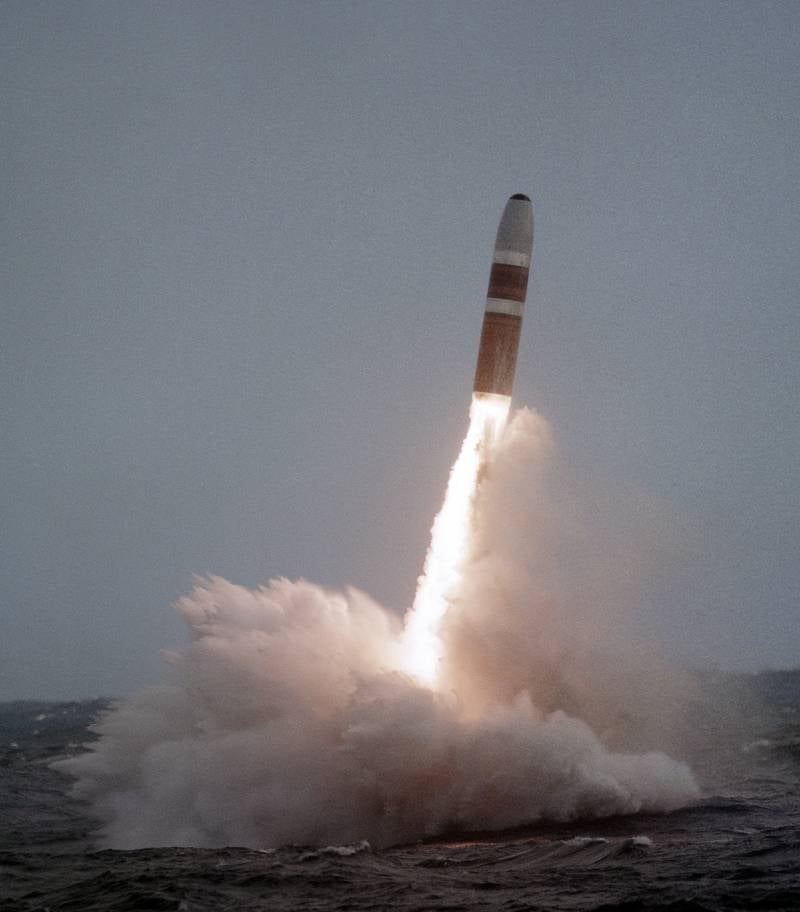
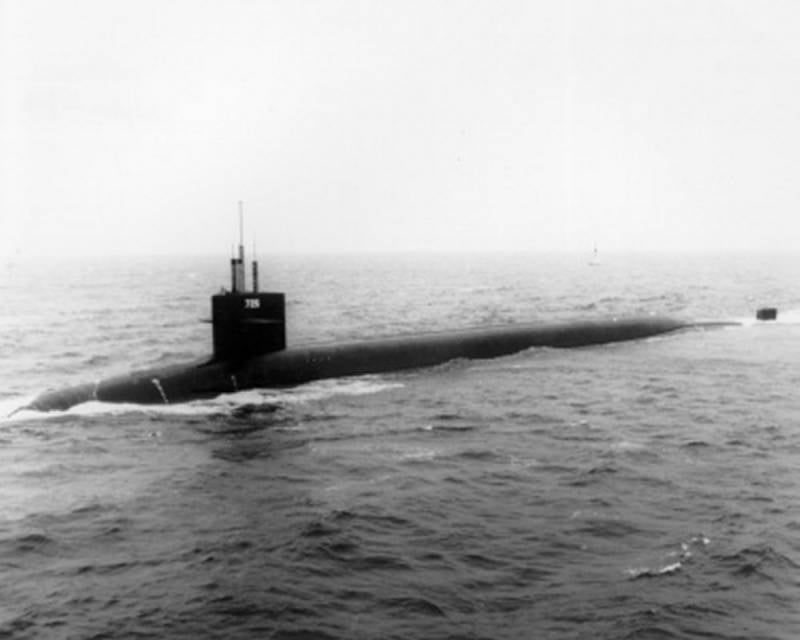
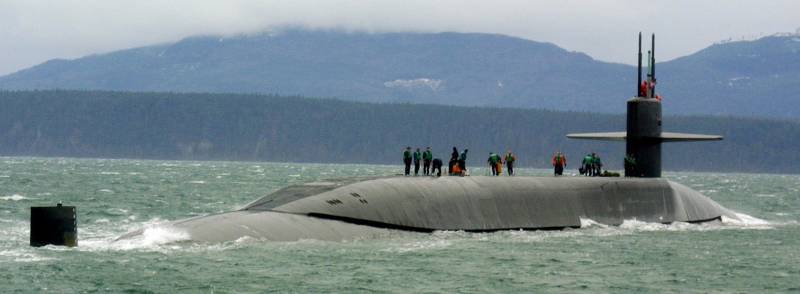
Information